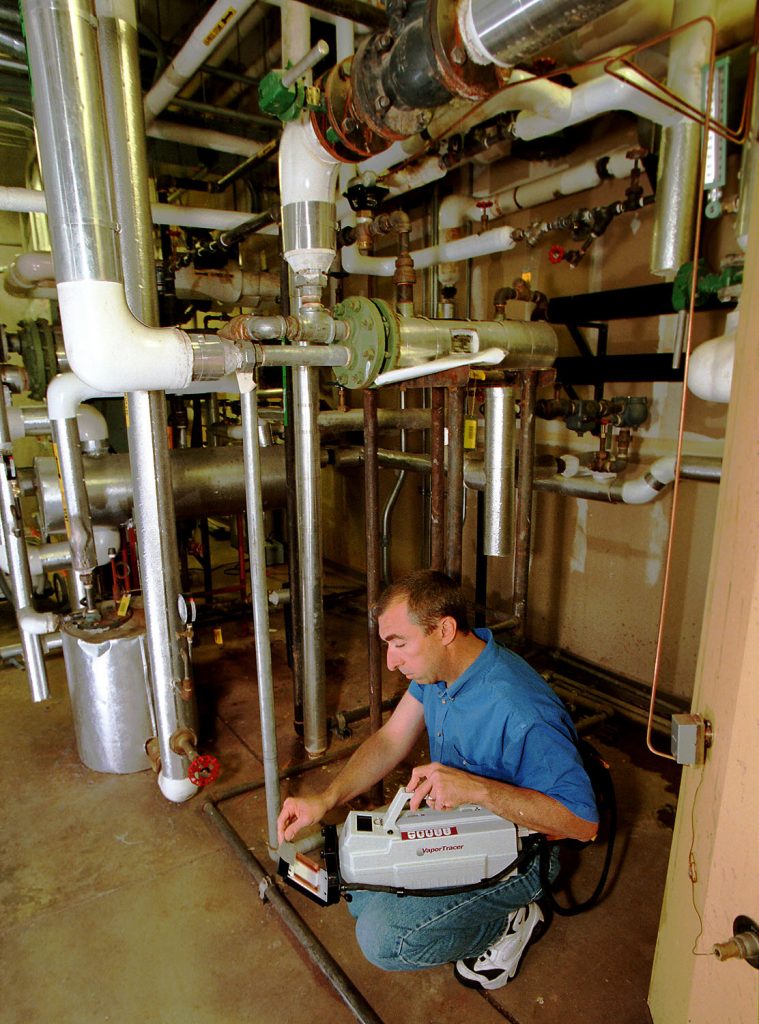
(Photo by Randy Montoya)
Download 300dpi JPEG image, ‘linker.jpg’, 180K (Media are welcome to download/publish this image with related news stories.)
ALBUQUERQUE, N.M. — You might call it an “electronic dog.”
Researchers at the Department of Energy’s Sandia National Laboratories have developed a hand-carried gadget that, like a trained police dog, could sniff out the vanishingly faint odors of drugs and bombs at airports, border crossings, military installations, and schools.
The portable device is a miniaturized version of an explosives-detecting walk-through portal Sandia developed for the Federal Aviation Administration (FAA). The portal, which blows a puff of air over an airline passenger and checks for minute levels of explosives in the air flow, might soon be seen at U.S. airports as a security screening tool.
Kevin Linker, Sandia project leader for the portal’s development, says recent improvements in the underlying chemical preconcentrator technology are enabling ever-smaller sniffing tools. “Miniaturization of the preconcentrator is allowing us to develop smaller detection tools that are portable, cheap, sensitive, and fast,” he says.
The preconcentrator works by drawing in a large volume of air, collecting heavy organic compounds from the air stream onto a filter, then vaporizing these organics into a smaller parcel of air that is delivered to a commercial explosives detector.
By drawing greater volumes of air past the filter using a clever design trick, the researchers have been able to shrink the preconcentrator’s largest feature — its air intake and valves — from a nine-inch diameter to a one-inch diameter, enabling increasingly smaller sniffers.
Portable crime-scene sniffers
Already Sandia has developed for the FBI a sandwich-sized chemical preconcentrator that fits onto the front of a commercial hand-carried ion mobility spectrometer (IMS).
Now, rather than take crime-scene swipes of chemical particulates back to a crime lab for analysis, forensics investigators can place the swipes into the portable sniffer for analysis on the spot. The preconcentrator heats up the swipe and draws the vaporized compounds into the IMS for detection. In all, the swipe sniffer is about a size of a large lunch box.
The device expands crime-scene investigators’ capabilities to detect residues of both explosives and narcotics, says developer Dave Hannum. With the Sandia preconcentrator, the portable IMS is much more sensitive, capable of detecting less than a nanogram of explosives residue on the swipe. For comparison, the fingerprint of a person who had handled a bomb or a suitcase with explosives in it would likely contain 100,000 times more residue, he says.
With the new device many more chemical analyses can be performed by forensics teams at the crime scene, which may improve the quality of evidence collected, Hannum says.
Sandia is exploring licensing opportunities for the device, and the FBI has requested several more of the sniffers for use in field investigations.

(Photo by Randy Montoya)
Download 300dpi JPEG image, ‘hannum.jpg’, 381K (Media are welcome to download/publish this image with related news stories.)
Air sniffer for lockers, border crossings
The second new instrument — also a Sandia preconcentrator fitted onto the front of a commercial IMS — can detect nanograms of explosives from several cubic feet of air drawn from the seams of a car trunk or school locker, for instance. The device might be useful for explosives detection at border crossings or during traffic stops.
Unlike a dog, the sniffer never gets tired, you don’t have to feed it, and you can switch it off when you don’t need it, says co-developer Chad Custer.
Although a dog’s nose is somewhat more sensitive than the sniffing device, says Linker, a trained dog can’t work reliably for more than 30 or 40 minutes without a rest.
“Dogs are very good at smelling things, so electronic sniffers may never be as good as a dog’s nose,” he says. “With a preconcentrator you can detect incredibly small traces of chemicals well enough without the logistics problems associated with dogs.”
Sandia is funding a New Mexico State University team to research whether the same IMS/preconcentrator combo can reliably detect narcotics, so far with promising results, he says.
Sandia has applied for patents on both portable sniffers.
Explosives, narcotics, and chem-bio agents in one sniff
Meanwhile, Sandia’s explosives-detecting airport portal is making its way to U.S. airports and might be used as early as spring 2000. Commercial rights to manufacture, sell, and service the portal technology are licensed to Barringer Instruments, Inc. of Warren, N.J. The deal was struck this summer following three years of development work at Sandia that began in 1995.
The Sandia team also is researching whether using a mass spectrometer, rather than an ion mobility spectrometer, as the portal’s detector would enable a next-generation airport portal to reliably detect explosives, narcotics, and chemical and biological warfare agents with one sniff.